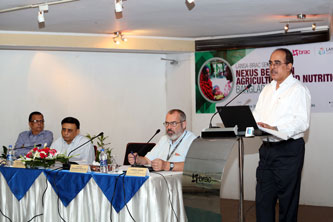A study has revealed that diversified agricultural production contributes to enhanced dietary diversity to help improve the nutritional outcome by reducing the level of malnutrition in Bangladesh. The nutritional condition of the families who produce other non-cereal agricultural crops like vegetables and fish, meat and poultry alongside food grains despite having a same level of income like of that of non-farm families is better. The study suggested increased investment in agricultural research and development, better market access and incentives for the farmers, where required, to ensure food and nutrition security in the country.
In his presentation, Researcher Uttam Deb said over the past three decades, agricultural diversification had place in Bangladesh. The production of vegetables, fish, milk, egg and meat increased significantly. The simultaneous development of farm and non-farm activities helped in enhancing the per capita income of the sample households from US$ 325 in 2011 to $ 448 in 2015. Besides, the livelihood diversification reduced the poverty level at a higher rate of 3.0 per cent among those families during the period of five years than that of the previous decade as food inflation decreased. «To increase food security and ensure nutrition security, Bangladesh must have to continue investment in agricultural research and development activities, better market access and ensure incentives for the farmers,» said Mr Uttam.
Read original article at thefinancialexpress-bd.com
6 septiembre 2016Original Author: FE Report

